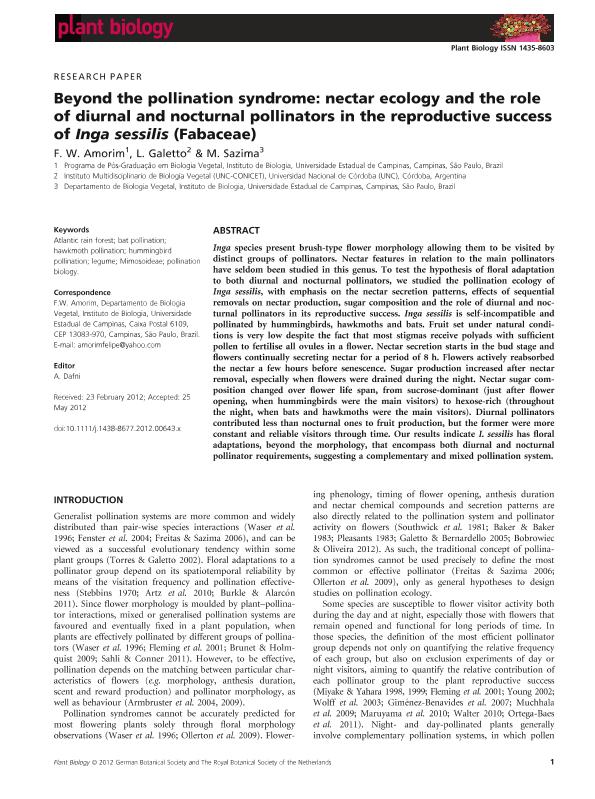Mostrar el registro sencillo del ítem
dc.contributor.author
Amorim, F. W.
dc.contributor.author
Galetto, Leonardo

dc.contributor.author
Sazima, M.
dc.date.available
2016-12-19T19:44:17Z
dc.date.issued
2012-07
dc.identifier.citation
Amorim, F. W.; Galetto, Leonardo; Sazima, M.; Behind the pollination syndrome: Nectar ecology and the role of diurnal and nocturnal pollinators in the reproductive success of Inga sessilis (Fabaceae); Wiley; Plant Biology; 15; 2; 7-2012; 317-327
dc.identifier.issn
1435-8603
dc.identifier.uri
http://hdl.handle.net/11336/9769
dc.description.abstract
Inga species present brush-type flower morphology allowing them to be visited by
distinct groups of pollinators. Nectar features in relation to the main pollinators
have seldom been studied in this genus. To test the hypothesis of floral adaptation
to both diurnal and nocturnal pollinators, we studied the pollination ecology of
Inga sessilis, with emphasis on the nectar secretion patterns, effects of sequential
removals on nectar production, sugar composition and the role of diurnal and nocturnal
pollinators in its reproductive success. Inga sessilis is self-incompatible and
pollinated by hummingbirds, hawkmoths and bats. Fruit set under natural conditions
is very low despite the fact that most stigmas receive polyads with sufficient
pollen to fertilise all ovules in a flower. Nectar secretion starts in the bud stage and
flowers continually secreting nectar for a period of 8 h. Flowers actively reabsorbed
the nectar a few hours before senescence. Sugar production increased after nectar
removal, especially when flowers were drained during the night. Nectar sugar composition
changed over flower life span, from sucrose-dominant (just after flower
opening, when hummingbirds were the main visitors) to hexose-rich (throughout
the night, when bats and hawkmoths were the main visitors). Diurnal pollinators
contributed less than nocturnal ones to fruit production, but the former were more
constant and reliable visitors through time. Our results indicate I. sessilis has floral
adaptations, beyond the morphology, that encompass both diurnal and nocturnal
pollinator requirements, suggesting a complementary and mixed pollination system.
dc.format
application/pdf
dc.language.iso
eng
dc.publisher
Wiley

dc.rights
info:eu-repo/semantics/openAccess
dc.rights.uri
https://creativecommons.org/licenses/by-nc-sa/2.5/ar/
dc.subject
Atlantic Rain Forest
dc.subject
Bat Pollination
dc.subject
Hawkmoth Polliniation
dc.subject
Hummingbird Pollination
dc.subject
Legume
dc.subject
Mimosoideae
dc.subject
Pollination Biology
dc.subject.classification
Ecología

dc.subject.classification
Ciencias Biológicas

dc.subject.classification
CIENCIAS NATURALES Y EXACTAS

dc.title
Behind the pollination syndrome: Nectar ecology and the role of diurnal and nocturnal pollinators in the reproductive success of Inga sessilis (Fabaceae)
dc.type
info:eu-repo/semantics/article
dc.type
info:ar-repo/semantics/artículo
dc.type
info:eu-repo/semantics/publishedVersion
dc.date.updated
2016-12-12T14:16:19Z
dc.journal.volume
15
dc.journal.number
2
dc.journal.pagination
317-327
dc.journal.pais
Reino Unido

dc.journal.ciudad
Londres
dc.description.fil
Fil: Amorim, F. W.. Universidade Estadual de Campinas; Brasil
dc.description.fil
Fil: Galetto, Leonardo. Consejo Nacional de Investigaciones Científicas y Técnicas. Centro Científico Tecnológico Córdoba. Instituto Multidisciplinario de Biología Vegetal (p); Argentina. Universidad Nacional de Córdoba; Argentina
dc.description.fil
Fil: Sazima, M.. Universidade Estadual de Campinas; Brasil
dc.journal.title
Plant Biology

dc.relation.alternativeid
info:eu-repo/semantics/altIdentifier/doi/http://dx.doi.org/10.1111/j.1438-8677.2012.00643.x
dc.relation.alternativeid
info:eu-repo/semantics/altIdentifier/url/http://onlinelibrary.wiley.com/doi/10.1111/j.1438-8677.2012.00643.x/abstract
Archivos asociados
